This marketing guide is specifically designed for service-based businesses in Australia. While several of the steps also apply to e-commerce businesses, selling physical products online involves different considerations.
If your business is built around delivering a service, this plan will provide you with a clear, step-by-step marketing roadmap to create visibility, attract the right clients, and grow with confidence.
We have also included prices, or estimated costs, so you can see what your investment will be at each stage.
1. Foundations
Before diving into marketing tactics, it is essential to establish a solid foundation for your business. These early decisions shape how potential clients will perceive your brand, find you online, and remember you later.
This stage involves selecting a business name, registering your domain, considering a trademark, clearly defining your services, and focusing on delivering excellent results from the start. These one-time decisions are made early in your business journey, and getting them right sets the tone for everything that follows.
Choose a Business Name
Cost: $44 per year – go to register.business.gov.au to register

Your business name is often the first impression you make, so it needs to be memorable, relevant, and aligned with the services you offer. For service-based businesses, a clear and professional name helps build trust, signals credibility, and supports long-term brand recognition.
One of the most common missteps new business owners make is choosing a name they like without considering how it will translate to their online presence. A name that sounds clever or creative in conversation might not work as a domain name, could be challenging to spell, or might already be taken.
Before you lock in a name, check that the domain is available and that it looks clean and professional as a URL. Also, search for your business name on Google to make sure no one else is using it online – At least in Australia.
Consider how your business name will appear on a business card, in a social media handle, and as part of your email address. A name that is easy to spell, pronounce, and remember will serve you better across every marketing channel.
This is a foundational decision, so take your time to get it right. It sets the tone for your brand and how people will talk about your business, both online and offline.
Register a domain name
Cost: varies – usually $20+ per year – Register with a domain registrar, e.g. VentraIP

In Australia, the cost to register a domain name depends on the domain extension and the registrar you use. When you register a domain name, you will need to choose a Top-Level Domain (TLD), such as .com, .com.au, .net.au, or simply .au, which appears at the end of your domain. Each TLD carries different implications. To register a .au domain, you must have an Australian Business Number (ABN) or Australian Company Number (ACN), as it is reserved for entities with a verified Australian presence.
Although you pay to register a domain, you do not technically own it. Instead, you are granted exclusive rights to use that domain name for a set period, usually one or two years, with the option to renew it. If you fail to renew it on time, the domain can be released and registered by someone else. Domains are managed through authorised organisations called registrars.
Ideally, your domain should match your business name exactly, making it easier for customers to find you online and reducing confusion. If the exact domain is not available, you might want to reconsider your business name, especially if there is a competitor in a similar industry with a similar business name.
Avoid adding unnecessary words or hyphens, as these can be easily misremembered or mistyped. A strong domain reinforces your brand identity and ensures consistency across all marketing channels.
Consider a trademark
Cost: From $250 – go to IP Australia to register, or engage an Intellectual Property Lawyer.
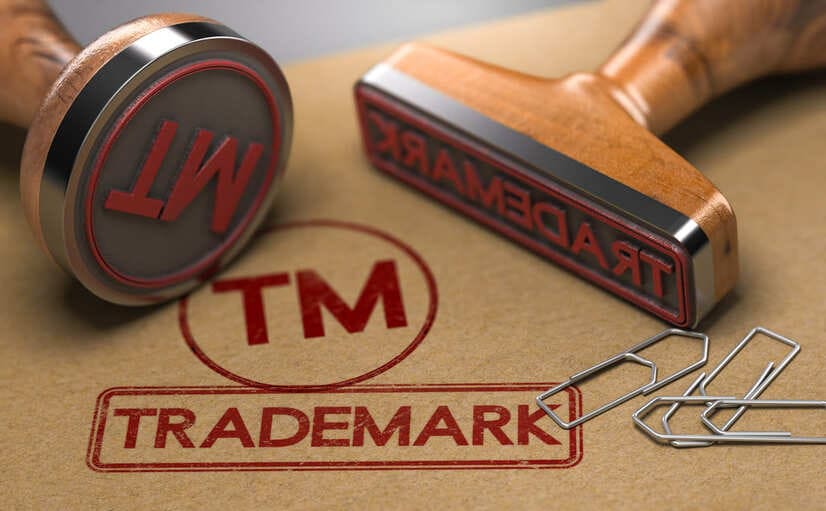
Many small businesses in Australia overlook the importance of trademark registration. While registering a business name gives you the right to conduct business under the name, it does not provide ownership of your brand name, logo, or slogan, this is where trademark protection comes in.
A registered trademark gives you the exclusive legal right to use that brand element in connection with your goods or services. It helps prevent others from using something similar that could confuse your customers or harm your reputation.
Trademarks are registered through IP Australia, and although not mandatory, securing one early offers peace of mind, especially if you plan to grow, franchise, or expand your business.
Before committing to a business name or logo, check the Australian Trade Marks Online Search System (ATMOSS) to ensure your brand is not already in use.
Define your services and deliver great results
Cost: Free!

Once your business name and domain are secured, the next step is to clearly define what you offer and how you offer it. Many new service-based businesses fall into the trap of being too broad or too vague, which can lead to attracting the wrong type of clients or taking on work that does not align with your strengths or goals.
Your communication style also plays a significant role in shaping client expectations. Excellent service always wins, but that does not mean you need to say yes to everything or bend your boundaries. Being direct, respectful, and clear from the outset often builds more trust than overpromising or trying to please everyone.
When your messaging reflects what you genuinely enjoy and excel at, you will naturally attract clients who value your approach. Being clear about what you don’t offer is just as important as listing what you do.
Delivering a high-quality service, backed by consistent communication, is what drives referrals and repeat business. When your offerings are well-defined and your service experience is strong, your marketing efforts become more effective because the reputation you build will speak for itself.
Get a branded email account
Cost: from $6 per month through Microsoft. If you use an IT company to setup your email account, there will usually be a set up fee plus a higher monthly cost.

Nothing says you’re not a serious business like a Gmail or Yahoo email account. While there’s nothing wrong with these types of email accounts for personal use, sending emails to your customers from a branded email account shows you’re a legitimate business.
A branded email account is one that ends in your domain, e.g. john.smith@paramark.com.au. You’ll need to register a domain name for your business to get a branded email address.
From there, it’s a matter of choosing an email service provider for your email account. There are only two email service providers I’d recommend: Microsoft 365 Exchange and Google Workspace. These service providers provide industry-standard email deliverability, security and allow you to efficiently manage your business’s email accounts as your business grows.
While many website hosts offer email accounts, I’d recommend staying away from these. They could be PHP-based email accounts with terrible mailbox limits and poor deliverability, or whitelabeled versions of Microsoft 365 Exchange that are pared down and can cause problems if you later want to migrate to your own 365 account.
If you’re not tech-savvy, I recommend hiring an IT company to assist you with setting up your email account. They should provision you with either a Microsoft 365 or a Google Workspace email account. There will usually be an upfront setup cost, and they’ll likely add a margin to the monthly licence cost to cover account management and support. Although no one likes extra costs, your email account is probably one of your most vulnerable assets, and if it gets hacked, the consequences could be astronomical.
Although we don’t offer email services at Paramark, if you contact us, I can refer you to the IT consultant we use for our email accounts.
2. Establish Your Presence
Establishing your online presence means creating a consistent and credible identity across various platforms, including Google Business Profile, social media, your website, and email. Each of these accounts contributes to how potential customers find and engage with your business, so it is important to set them up thoughtfully and manage them securely. A common risk for small businesses is losing access to these accounts due to misplaced passwords, forgotten login details, or relying too heavily on staff or contractors who may no longer be involved in the business.
To avoid these issues, establish a clear and secure system from the beginning. Use a centralised password manager to store login credentials, recovery emails, and two-factor authentication. This makes it easy to manage and update your accounts as needed while keeping your business protected. Most importantly, ensure that you, as the business owner, retain direct access to every account associated with your business. This approach reduces the risk of lockouts and gives you full control over your digital presence as your business evolves.
Create a Google Business Profile
Cost: Free! Go to https://business.google.com/aunz/business-profile/ to register your business profile. Some marketing agencies also offer GBP registration assistance as a service, including Paramark. Contact us for a quote to help you set up your Google Business Profile.
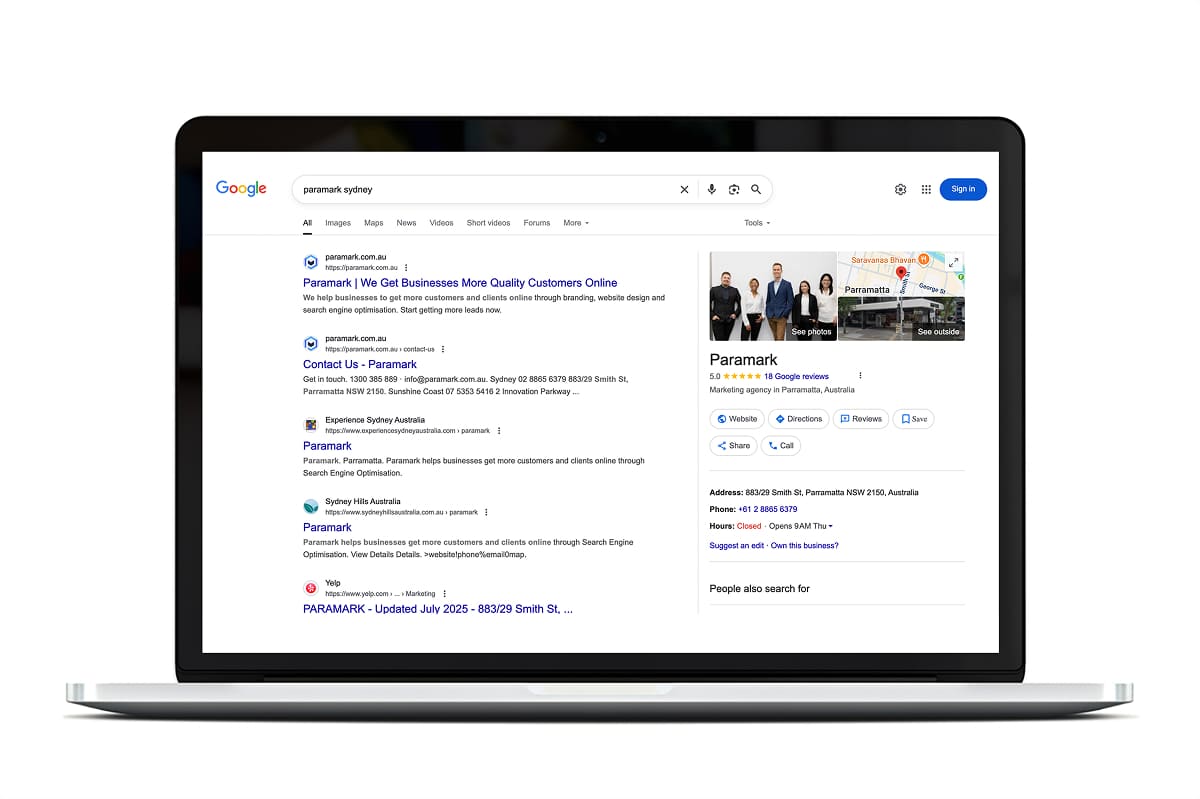
With your services clearly defined and your foundations in place, the next step is to establish your presence, starting with one of the most powerful (and often overlooked) tools available to local businesses: Google Business Profile.
Creating a Google Business Profile sets the foundation for appearing in local search results, Google Maps, and the “local pack” that appears at the top of search listings. For service-based businesses, this can be a solid source of traffic, enquiries, and trust, especially when potential customers are searching for services in their area. A well-optimised profile helps Google understand what you offer, increases your chances of showing up in relevant local searches, and signals to customers that your business is established and credible.
Once your profile is created, take the time to optimise it fully. Upload high-quality photos that reflect your work, team, or workspace, as visuals play a significant role in building trust. List your services using the available categories and fields, and write a helpful business description that reflects your brand voice. Encourage happy clients to leave reviews, and make sure to respond to each one. This shows prospective customers that you are engaged and professional.
An accurate, complete, and regularly updated Google Business Profile improves your visibility and helps create a positive first impression. It is a simple but powerful step in building your business’s presence both online and in your local community.
Set up social media pages
Cost: Free!
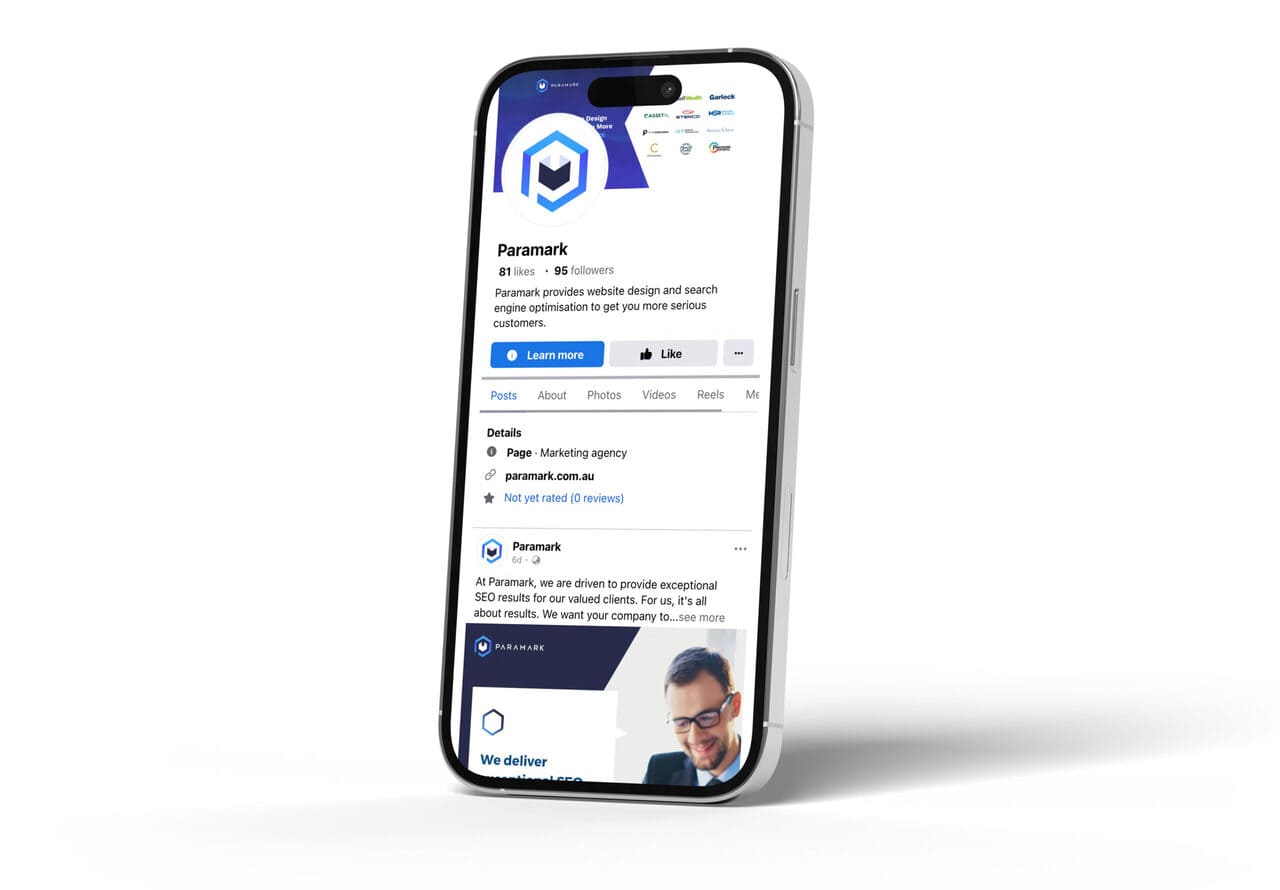
When used intentionally, social platforms for service-based businesses build brand visibility, connect with customers, and showcase your expertise.
Begin by identifying the platforms that are most relevant to your target audience. For example, Facebook is ideal for reaching local communities and running location-based promotions. Instagram is well-suited for visually engaging services, such as beauty, design, or home improvement, while LinkedIn is more suitable for professional services or B2B offerings. You do not need to be everywhere; choose one or two platforms where your audience is already active and where your services naturally fit the format.
When setting up your profiles, consistency is key. Use the same logo, business name, and tone of voice consistently across all platforms to reinforce your brand. Complete every section of your profile, including your bio, contact details, and service information. High-quality profile and cover images go a long way in creating a professional first impression.
If you are in the early stages of your business, social media can serve as a simple yet effective platform where potential clients can find you, get a sense of what you offer, and reach out. If you do not yet have a website, a well-set-up social media page can function as your primary online presence until your budget allows for a custom website.
Join a local Chamber of Commerce or business network group
Cost: varies – usually starts at $1000 per year

While digital marketing plays a vital role in building your brand, in-person networking remains one of the lowest-cost, most effective marketing channels for service-based businesses in the early stages of business. Joining local business networking groups can introduce you to potential clients, collaborators, and suppliers, people who can directly or indirectly support the growth of your business.
If you enjoy connecting face-to-face, lean into that strength and prioritise networking. Many successful businesses grow through word of mouth and personal referrals long before they need to run ads or post online. Networking builds your reputation within the community and can lead to long-term relationships that online engagement alone may not achieve. However, it is worth noting that networking often requires a greater time commitment, with regular meetings and follow-ups all playing a role in building strong connections.
There are several types of networking groups to consider, each offering a distinct experience, structure, and level of commitment. BNI (Business Network International) is one of the most well-known referral-based networks, with weekly meetings and a structured approach to generating leads.
The key is to select groups that match your business goals and networking style. Start with one and attend regularly to build familiarity and trust. Networking is most effective when approached with a long-term relationship-building focus rather than a sales tactic.
P.S. If you’re in Sydney Northwest, contact us to come as a guest to the BNI group we’re in.
Nominate your business for awards
Cost: varies – entrance fee usually starts at $100 for awards

Entering local business awards can also boost your visibility, establish credibility, and position your business as a trusted service provider in your community. Even if you are in the early stages of your business, being nominated or shortlisted can provide exposure. At the same time, a win, big or small, offers third-party recognition that builds trust with potential clients.
Participating in awards also provides an opportunity to reflect on what makes your business different, highlight your achievements, and strengthen your marketing message. Many awards programs include press coverage, social media promotion, networking events, and the chance to feature award logos on your website and promotional materials.
When selecting which awards to enter, focus on those that are relevant to your industry, region, or stage of business. Your local council, chamber of commerce, and industry associations often host annual awards programs tailored to small and service-based businesses. Fees and eligibility vary, with some events being free to enter and others charging a submission or participation fee, typically ranging from $100 to $300.
To make your entry stand out, set aside time to prepare a strong, honest application. Use real data, testimonials, and examples of your work. If you are just getting started, focus on your story, why you started, who you serve, and how you are making an impact.
3. Build Trust and Visibility Online
Once you have established your presence and launched your website, the next step is to build trust, and that starts with what others say about your business.
Collect online reviews
Cost: Free! There are also paid tools that can help with collecting reviews.
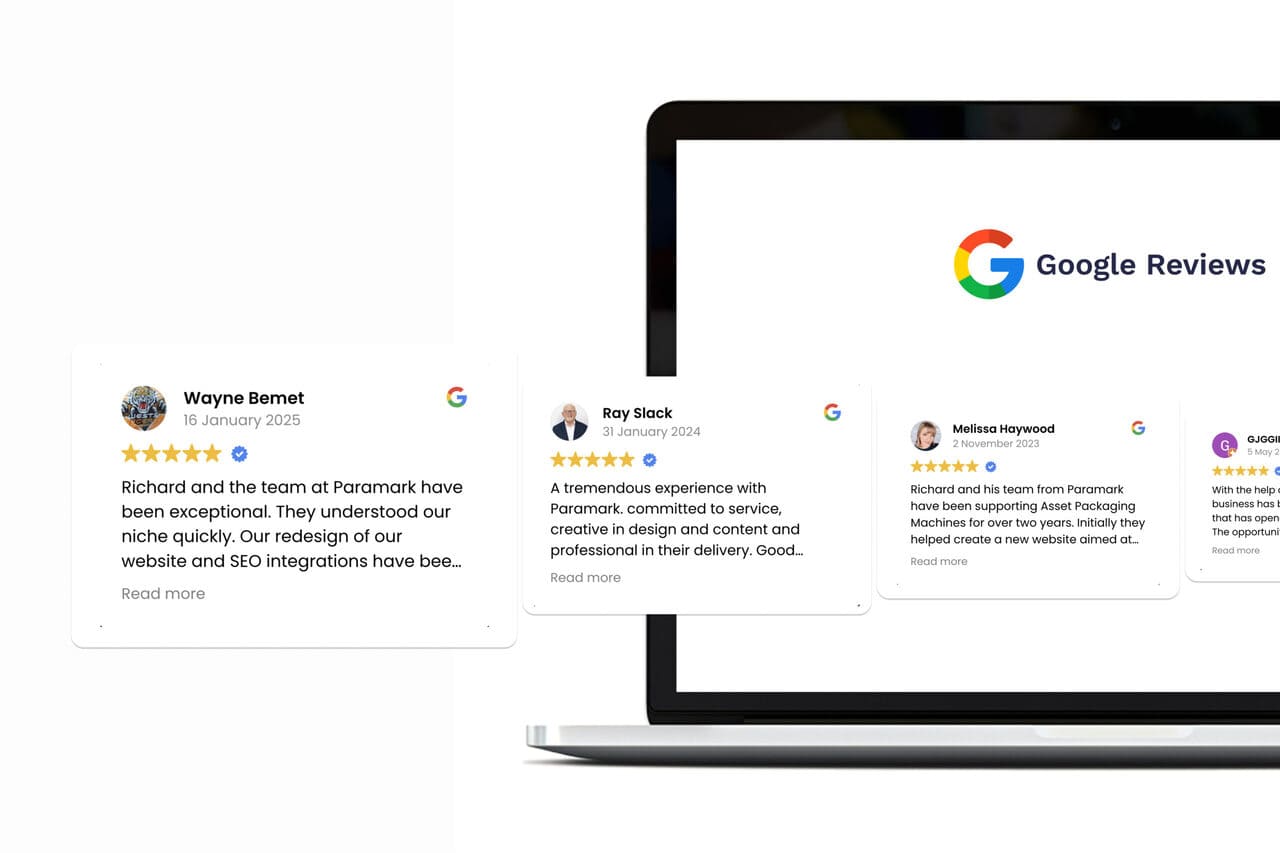
Online reviews play a key role in shaping how potential clients perceive your business. The most valuable platform for reviews is your Google Business Profile. Reviews here help improve your ranking in local search results and are often the first thing people see when they look up your business. However, you can also collect reviews on other platforms such as Facebook, Trustpilot, Word of Mouth, or industry-specific directories. While these additional reviews can be helpful, Google remains the most influential factor in terms of visibility and credibility.
There are paid tools that offer to manage or automate the review collection process, but these are not necessary when you are starting out, and they can add unnecessary complexity or create a barrier between you and your customers. A straightforward approach is often more effective.
Post in social media communities
Cost: Free!

Posting in local or industry-based social media communities can connect you with potential clients and build awareness. Facebook groups, community noticeboards, and neighbourhood platforms can be especially effective for service-based businesses. These spaces enable you to introduce your business, answer questions, share valuable advice, and establish yourself as a trusted local presence.
The key to success in these communities is striking the right balance between visibility and value. Avoid posting only promotional content. Instead, aim to contribute in a way that is genuinely helpful or interesting. Share tips related to your service, answer frequently asked questions, show behind-the-scenes glimpses of your work, or highlight community involvement. This builds trust and positions your business as approachable and knowledgeable, rather than sales-driven.
This approach is more effective for certain industries than others. Trades, home services, health and wellness providers, and pet care businesses often thrive in community groups where people seek personal recommendations. However, for more specialised or B2B services, other platforms like LinkedIn or in-person networking may offer better traction. As with all marketing, choose what aligns with your business type, target audience, and your preferred engagement style.
Get professional photography
Cost: varies – half-day professional photo shoot typically starts at $1500

High-quality images play a crucial role in how your business is perceived online. Whether it is on your website, social media pages, or Google Business Profile, professional photography can instantly elevate your brand and make your business appear more trustworthy, polished, and established.
People make fast visual judgments, and blurry, poorly lit, or generic stock photos can damage credibility. Investing in a professional photographer allows you to showcase the real people behind the business.
These images can then be used consistently across all platforms to create a strong, cohesive brand presence. A one-time investment in good photography can continue to pay off across all your marketing channels.
P.S. If you’re in Sydney, contact us and I can refer you to the photographer we recommend to our clients.
Launch a Professional Website
Cost: varies significantly – a completely done-for-you website from an Australian web designer with content writing included can start at $3,000
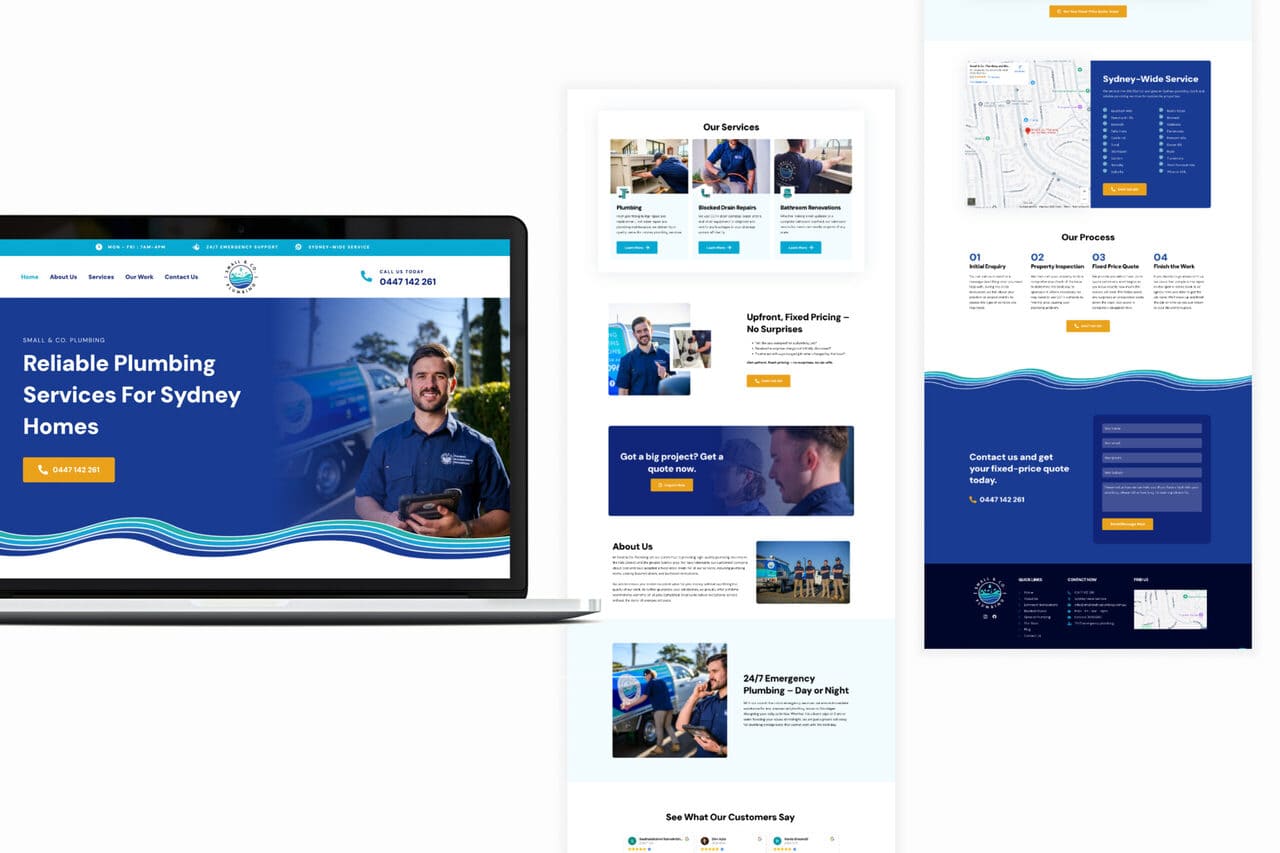
With your domain name secured, your brand messaging clarified, and your business growing, it is time to bring everything together with a professional website. This is where your digital presence becomes centralised, a place where potential clients can learn more about what you do, explore your services, and take action. Unlike social media platforms, which are subject to algorithm changes and third-party control, your website is a business asset you can fully own and manage.
A well-designed, custom website does more than just look good. It builds trust, communicates your message clearly, and works behind the scenes as a 24/7 salesperson, sharing your value, guiding visitors, capturing enquiries, and even automating tasks like booking requests, quote forms, or client onboarding, depending on your industry. It supports your long-term marketing efforts and sets the standard for how your business is perceived.
One of the common mistakes small business owners make is rushing into a website build without a clear plan or adequate budget. A professional website takes time, money, and expertise to get it right. For example, the essential components of industrial websites may be different to what works for other sectors. Cutting corners might save you money upfront, but can lead to costly rebuilds, lost enquiries, or damage to your credibility.
Behind every reliable website is reliable hosting. Hosting is the service that stores your website files and makes them accessible to visitors online. Fast, secure website hosting ensures your website loads quickly, stays online, and remains protected from potential threats. Australian service-based businesses should look for hosting providers with Australian-based servers, automatic backups, SSL certificates, and responsive local support. Poor hosting can result in slow load times, technical issues, and even lost enquiries, and it is important to choose a provider that prioritises performance and security.
Is it time to get a website for your business? Have a look at some of the websites we’ve designed and the results we’ve achieved for our clients.
4. Promote your business strategically
Once your website is live and you have a social media presence, the next step is to attract the right people. This is where strategic promotion comes in: combining both organic traffic (visitors who find you organically through search engines, social media, or referrals) and paid traffic (visitors who arrive through paid ads on platforms like Google Ads, Facebook, or Instagram).
Paid campaigns are ideal for generating quick visibility, driving targeted leads, and testing offers. They enable you to target a specific audience with precision and achieve results in a shorter timeframe. On the other hand, organic traffic builds trust, credibility, and long-term authority. It is earned through consistent content creation, search engine optimisation, and ongoing engagement. While it takes longer to build, it delivers better value over time.
When deciding how to invest your marketing budget, consider both short-term goals and long-term returns. Marketing for construction companies, for example, differs from marketing for manufacturing businesses and financial services marketing. Paid advertising can deliver immediate results but requires continuous investment to sustain a steady flow of leads. Organic strategies, on the other hand, require time and consistency, yet continue to generate traffic and leads long after the initial effort has been made.
Evaluating the return on investment (ROI) of each strategy is essential. This includes not just the number of leads or clicks you get, but the quality of those leads and how many convert into paying customers. Monitor the performance of each channel over time and adjust your strategy accordingly. A balanced approach that combines both paid and organic tactics—tailored to your goals, audience, and resources—will give your business the visibility and momentum it needs to grow.
Search engine optimisation
Cost: Varies significantly. The cost for a reputable Australian marketing agency to provide Search Engine Optimisation services usually starts at $1,500 per month. See more about SEO costs here.
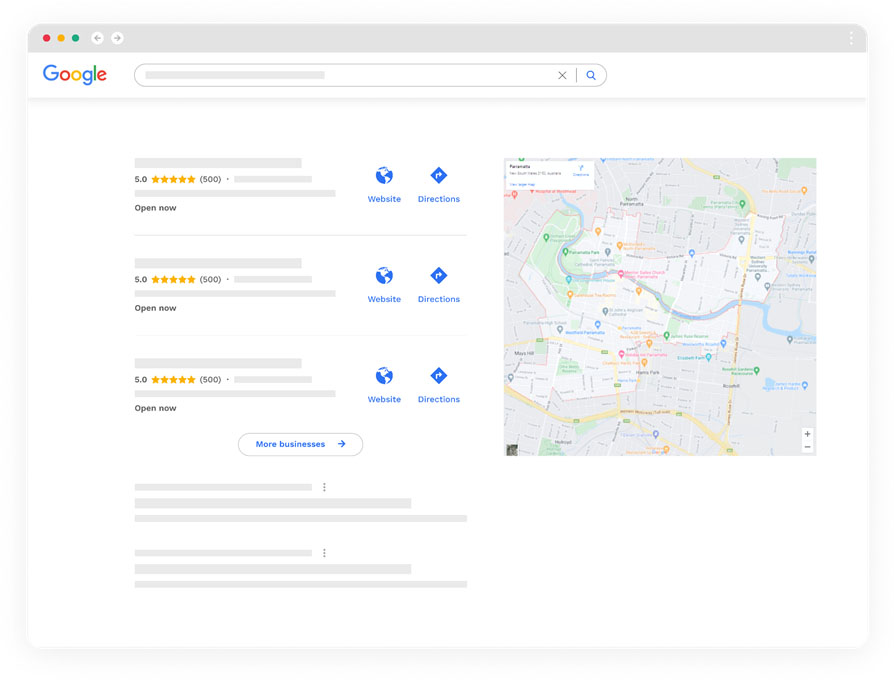
A well-designed website is only valuable if people can find it, and the reality is, most web pages never rank on Google or receive organic traffic. One of the most common misconceptions is that launching a website guarantees visibility. In truth, online visibility requires a strategic search engine optimisation (SEO) strategy that helps search engines understand, prioritise, and serve your content to people actively searching for your services.
Search engines, notably Google, remain the dominant way potential customers discover businesses online. To improve visibility, your website must be optimised both on the surface and behind the scenes. This includes structuring your pages for relevance, through headings, keywords, and metadata, and ensuring your site is technically sound. Technical SEO involves key elements, including site speed, mobile responsiveness, secure HTTPS connections, clean URL structures, and schema markup.
SEO is a long-term investment, not a quick fix, particularly when targeting competitive keywords or launching a new website. If you are starting out with this strategy, have a look at these SEO tips for beginners to get an understanding of what is involved. It’s also worth understand what SEO is, so you can strategically incorate it into your marketing strategy when the time is right. Whether you manage your SEO yourself or work with a professional, the goal remains the same: make it easy for the right people to find you online and compel them to take action once they do.
Wondering what SEO could achieve for your business? Have a look at some of the results we’ve achieved for our clients.
Google Ads
Cost: Google Ads agency costs also vary significantly, with some charging an upfront fee, some charging an ongoing fee, and some charging both. Ad spend can vary significantly as well.
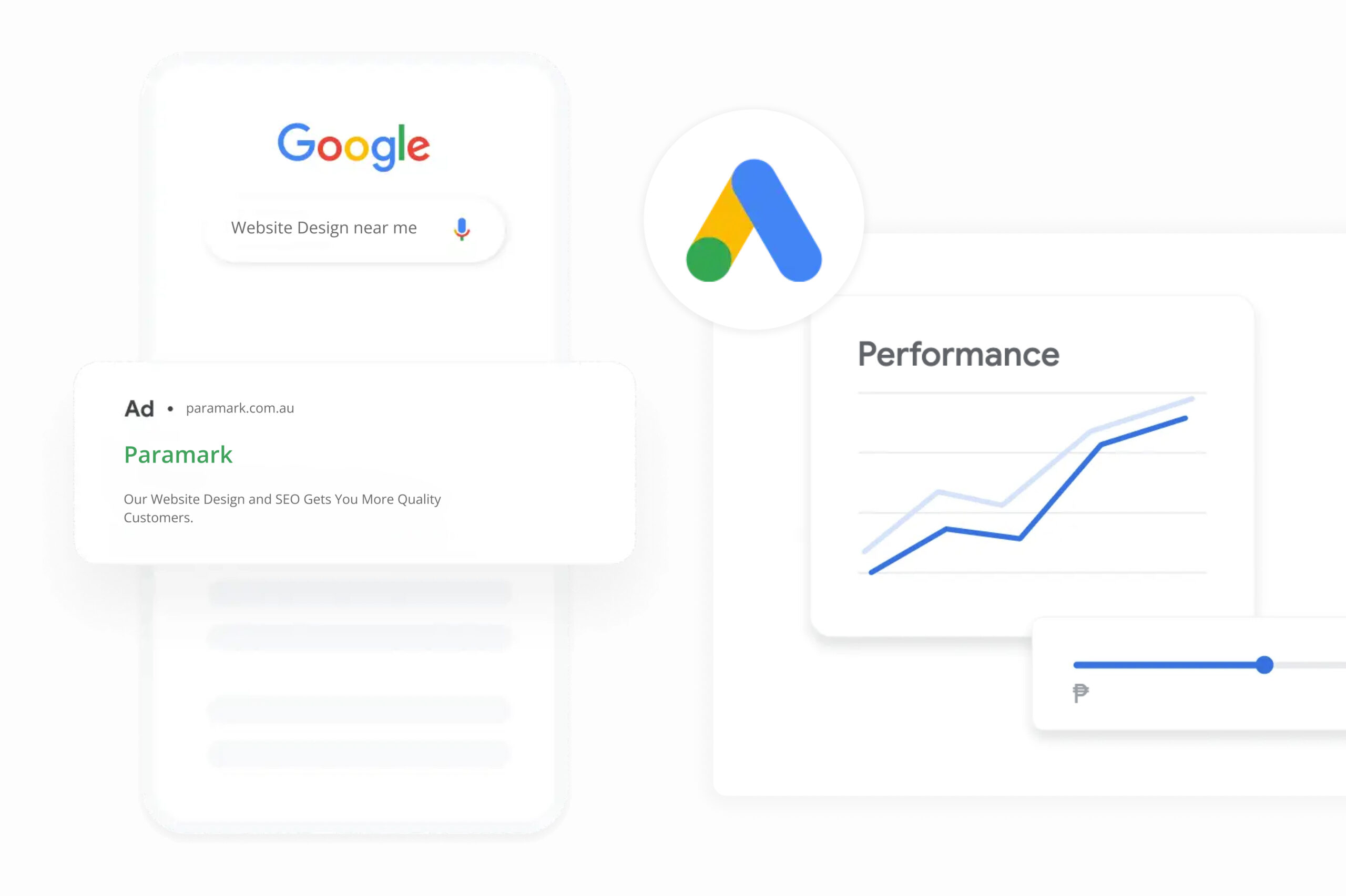
Google Ads operates on a pay-per-click (PPC) model, meaning you only pay when someone clicks on your ad. These ads appear at the top of Google search results, often above the organic listings, giving your business immediate visibility.
The strength of Google Ads lies in its intent-based targeting. Unlike social media ads, where you interrupt someone’s browsing experience, Google Ads are shown to people who are already looking for a solution. Whether they are searching for “plumber near me” or “small business accountant Adelaide,” your ad can appear at the right time when they are ready to take action.
You can set up campaigns to target specific keywords, locations, and even the times of day your ads appear. Each click leads directly to your website or landing page, where visitors can learn more, submit an enquiry, or make a booking. You can also track performance in detail, measuring how many clicks, calls, or conversions each ad delivers.
While Google Ads can generate leads quickly, it requires careful planning to avoid wasting budget. Poor targeting, weak ad copy, or an underperforming website can limit results. When managed well, however, it offers one of the fastest and most measurable ways to drive traffic and grow your business, especially while your organic rankings are still building.
Social Media Marketing
Cost: You can create and post your own social media content for free. There are also paid ad services and social media content creation services available.
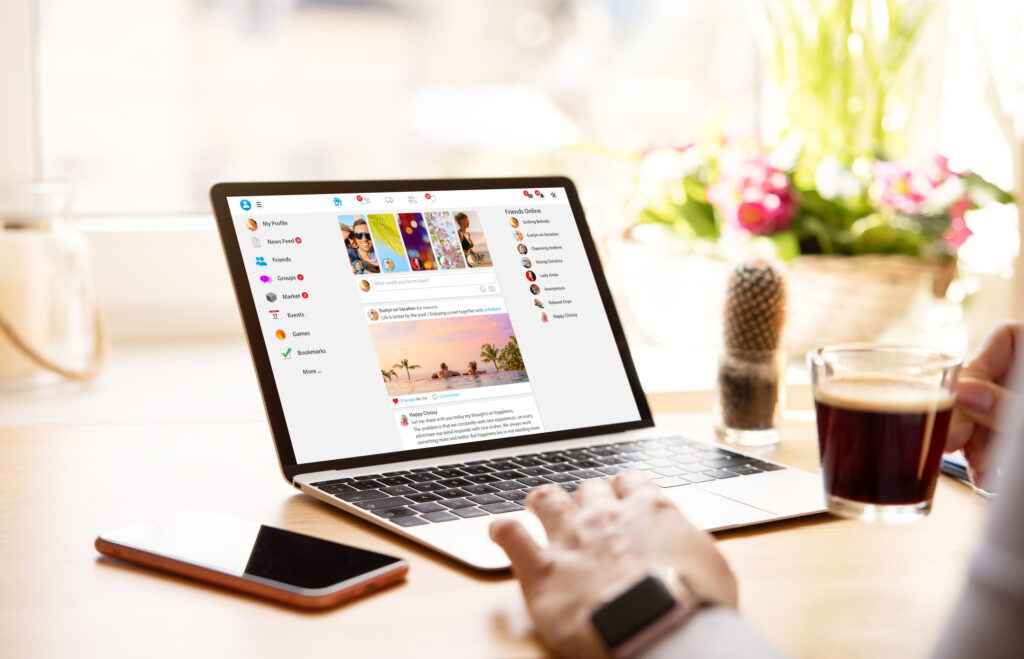
Social media platforms are powerful tools for building brand awareness, engaging your community, and driving targeted traffic to your website. To get the most out of them, it is important to understand how organic and paid strategies work, both individually and in conjunction.
Organic social media refers to the unpaid content you post through your business profile, such as updates, stories, reels, videos, and behind-the-scenes moments. This type of content helps showcase your business’s personality, share your expertise, and build trust with existing and potential clients. Consistent posting and genuine engagement can still foster loyalty and keep your brand visible to those who already follow or interact with you.
For businesses ready to expand their reach or generate leads quickly, paid social media advertising offers the advantage of precise targeting. Platforms like Facebook, Instagram, and LinkedIn allow you to target specific audiences based on location, demographics, interests, and behaviour. Whether you are promoting services, retargeting website visitors, or launching an offer, social media ads provide measurable results and can be tailored to suit almost any budget.
The most effective approach combines both organic and paid strategies. Organic content helps build credibility and emotional connection, while paid ads amplify your message and drive action. For example, you might use organic posts to share expertise, then retarget engaged visitors with a service promotion, or boost high-performing content to reach a broader audience.
Email outreach
Cost: Free – but there are software requirements to get started. Some agencies offer email outreach services, which might come with an upfront cost of $3,000 or more, and may also include an ongoing fee.

Email outreach is a direct marketing strategy designed to initiate one-on-one conversations, primarily targeting decision-makers in business-to-business (B2B) environments. Unlike mass email campaigns or newsletters, outreach is about targeted communication that builds genuine connections. It is most effective when used to introduce your business to a carefully selected audience, offer something of value, and open the door to further engagement.
Delivering your email into someone’s inbox is not easy. Deliverability depends on a technically sound email setup, including authentication records (SPF, DKIM, and DMARC), domain reputation, sending limits, and engagement history. Outreach software can assist, but it must be configured correctly to avoid being flagged as spam or landing in junk folders.
An email outreach agency can handle both the technical and strategic components. Typically, they provide end-to-end services, including list building, campaign design, message personalisation, software configuration, and performance reporting. They can also help ensure compliance with Australian spam laws by setting up clear opt-out mechanisms and ensuring messages are properly identified.
Letterbox drops
Cost: Free if you do it yourself. There are letterbox drop services that provide this service for a fee, with some as low as $200 for a run, which doesn’t include the cost of printing.

Letterbox drops are best suited for business-to-consumer campaigns, especially when targeting a geographic area. They are effective for local service-based businesses such as trades, real estate agents, dining, and personal care providers. With broad local appeal, letterbox drops allow you to reach households directly, raise awareness, and generate enquiries within your immediate community.
Set up remarketing ads
Cost: varies significantly; most marketing agencies that offer this service charge an upfront fee, often $2,000 or more, and sometimes an ongoing fee. You may need to pay for video production or photography separately, depending on the type of remarketing ads you use. You will also need to pay ad spend, which can be as low as $5 per day, depending on the platform and your audience size.
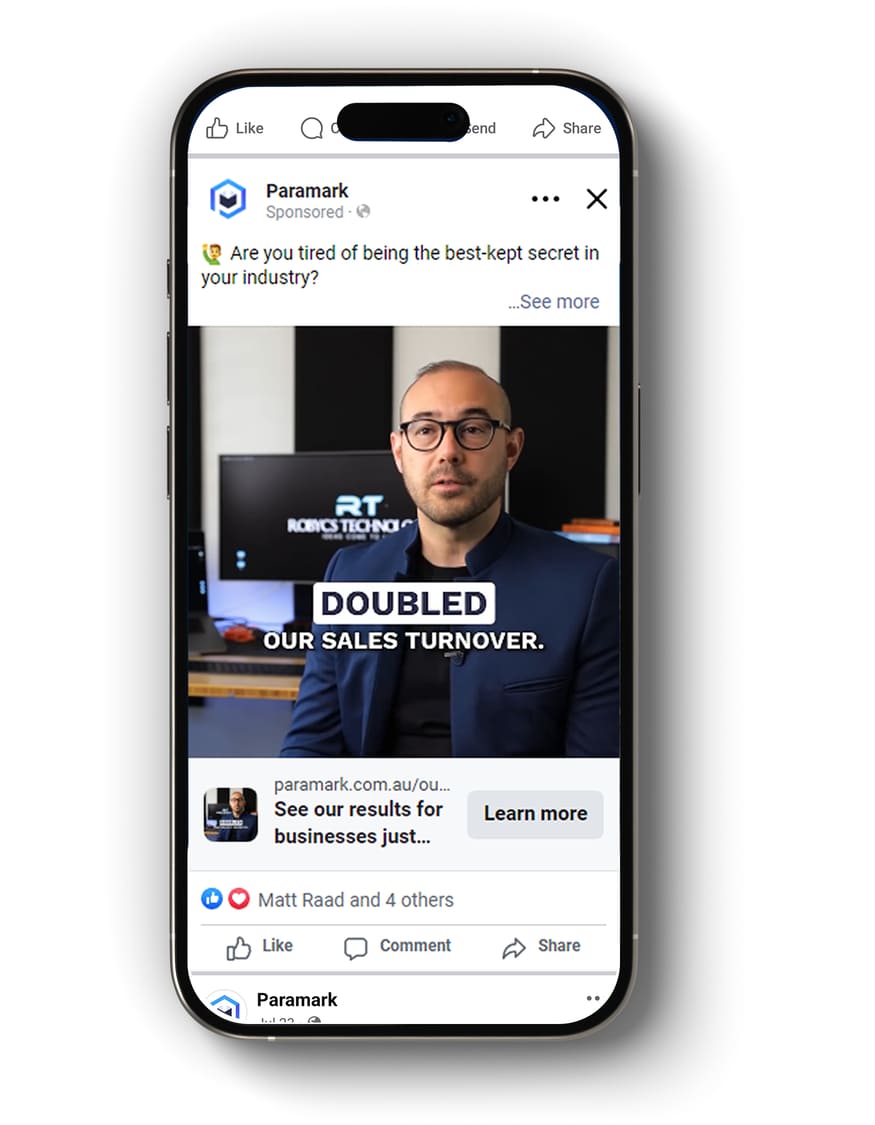
Not every website visitor will take action the first time they land on your site, but that does not mean the opportunity is lost. Remarketing, also known as retargeting, allows you to re-engage visitors by displaying targeted ads after they have left your website. These ads appear as they browse other websites, scroll through social media, watch YouTube videos, or search on Google.
Remarketing can take several forms, including text ads on Google Search, display banners across websites, image or carousel ads on Facebook and Instagram, and short video ads on platforms like YouTube. The format you choose can be tailored to your goals, whether you want to reinforce brand awareness, highlight a specific service, or drive traffic back to a key page on your site.
This type of advertising is effective because it targets individuals who have already shown interest in your business. Whether someone views a specific service page, visits your homepage, or abandons a contact form, remarketing helps guide them further down the decision-making path and encourages them to return when they are ready to take the next step. When used strategically, remarketing is one of the most efficient ways to turn website visitors into customers.
Content marketing and industry Insights
Cost: Free if you do it yourself. Fees for content creation by a marketing agency vary significantly. Expect to pay at least $1,000 a month for ongoing content creation, with one-off items often charged at a higher price.

Content marketing plays a pivotal role in supporting your SEO efforts by helping your website appear in more search results and positioning your business as a trusted authority. While it is often referred to simply as “blogging”, content marketing includes a wide range of value-driven content, including industry news, expert insights, helpful guides, how-to articles, company updates, and answers to common questions your audience is seeking. Every piece of content you publish gives search engines more context about your business and helps potential customers find you through relevant keywords and topics. When planned strategically, content marketing not only boosts your visibility in search but also builds credibility, educates your audience, and keeps your website fresh and active, all of which are essential for long-term SEO success.
One of the advantages of long-form content is that it can be repurposed into shorter, high-impact formats. A single blog post or article can be broken down into multiple social media posts, infographics, email snippets, or short videos, making it easier to maintain visibility and consistency across platforms.
5. Retain and Grow
Retaining clients and delivering on your promises is where real business growth happens. You can have the most well-crafted marketing strategy in the world, but if the customer experience falls short, the results will never be sustainable. People remember how you made them feel, how easy it was to deal with you, and whether you delivered what you promised.
If your business offers a premium or high-end service, your client experience must reflect that. Every touchpoint, from communication to delivery, should feel intentional, polished, and professional. Clients paying a premium expect more than just a service; they expect attention to detail, responsiveness, and follow-through.
On the other hand, if your offering is more practical or task-based, focus on making it as seamless and straightforward as possible to reengage. Whether that means easy online bookings, fast responses, transparent pricing, or convenient follow-up reminders, the goal is to remove friction and make returning to you the obvious choice.
Ultimately, delivering consistent value, exceeding expectations, and building trust is what turns first-time customers into long-term clients and long-term clients into your strongest advocates.
Launch a loyalty program
Cost: depends on what you offer!

An effective way to retain customers and encourage repeat business is through loyalty programs. Service-based businesses can create loyalty programs to foster ongoing engagement, encourage referrals, or repeat bookings.
A well-designed loyalty program builds goodwill, strengthens relationships, and provides customers with a reason to choose you again over a competitor. It does not have to be complex. For service-based businesses, loyalty incentives might include:
- Discounts on future services after a certain number of visits
- A complimentary consultation or check-in after a set period
- Priority scheduling or member-only perks
- Referral rewards that benefit both the referrer and the new client
- Exclusive access to content, early booking windows, or seasonal promotions
The key is to make your loyalty offering valuable, easy to understand, and aligned with the way your customers already use your services. By recognising and rewarding loyalty, you create a positive feedback loop.
Set up email marketing
Cost: If you’re doing things yourself, email marketing software like Mailchimp can start at $30 per month. If you choose to use an agency to manage your email marketing, expect to pay at least $1,000 per month.

Email marketing remains an effective tool for building relationships, nurturing leads, and encouraging repeat business. With the right strategy in place, your email list becomes a business asset, helping to move people from initial awareness to meaningful action, whether they are brand-new leads, active clients, or past customers you want to re-engage.
A strong email marketing strategy includes targeted email sequences tailored to different stages of the customer journey.
New lead sequences are designed to introduce your brand, explain your services, and establish trust with individuals who have recently discovered your business. These emails might include a warm welcome, a brief overview of how you help, testimonials, case studies, or links to helpful blog posts. The goal is to educate and engage so that when the potential client is ready to take action, your business is front of mind.
While client email sequences come into play later in your business journey, they are worth planning for early. Having these systems in place helps you deliver a consistent service experience and reduces the risk of missed follow-ups or lost repeat business. These sequences can include appointment confirmations, quote follow-ups, service reminders, or a simple thank-you after a job is complete. Over time, they can also be used to introduce related services, request reviews, or invite customers to join a loyalty program. By thinking ahead and setting up these touchpoints now, you are laying the groundwork for stronger client relationships and long-term retention.
Re-engagement campaigns are designed to reconnect with past clients or email subscribers who have not engaged with your business in a while. These emails may include personalised offers, helpful tips, new service updates, or links to your latest blog post or promotion.
Invest in merchandising
Cost: branded products from Vistaprint can be purchased for as low as $10 + delivery.

Branded merchandise is a simple yet effective way to reinforce your brand identity. Unlike digital content that can be easily overlooked, physical items create a lasting impression, especially when they are practical and well-designed.
For service-based businesses, merchandising is about visibility and utility. Items like branded notepads, pens, magnets, calendars, or even reusable shopping bags can stay in homes, cars, or offices long after the initial interaction. Each time your client sees or uses that item, your brand is subtly reinforced.
Magnets are ideal for trades and home services, offering a quick reference for rebooking. Even a small gesture, such as including a branded thank-you card or gift in a service package, can build goodwill and strengthen client relationships.
The key is to choose merchandise that aligns with your brand personality and provides genuine value to your client.
Turn your marketing strategy into action for business growth
Marketing a service-based business is not about chasing every tactic all at once; it is about having a clear strategy and implementing each step in a focused and deliberate manner. When you take the time to lay the right foundations, build trust, and promote your business with intention, the results compound. The most effective marketing plans are built on consistency, clarity, and a deep understanding of your goals. That is why it is so important to collaborate with a partner who is genuinely committed to your success, someone who takes the time to understand your business, your industry, and your customers. At Paramark, we work closely with service-based businesses to create tailored marketing strategies, build high-performing websites, and manage all the daily requirements of your website. If you are ready to take the next step, contact us to explore whether Paramark is the right fit to support your business goals and growth.






